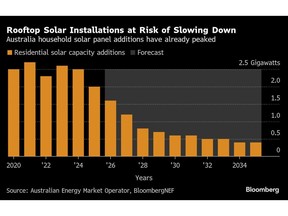
Article content
(Bloomberg) — Australia started a A$2.3 billion ($1.5 billion) program to encourage households to buy batteries in an effort to absorb excess renewable energy and curb price swings in one of the world’s most volatile power markets.
THIS CONTENT IS RESERVED FOR SUBSCRIBERS ONLY
Subscribe now to read the latest news in your city and across Canada.
- Exclusive articles from Barbara Shecter, Joe O'Connor, Gabriel Friedman, and others.
- Daily content from Financial Times, the world's leading global business publication.
- Unlimited online access to read articles from Financial Post, National Post and 15 news sites across Canada with one account.
- National Post ePaper, an electronic replica of the print edition to view on any device, share and comment on.
- Daily puzzles, including the New York Times Crossword.
SUBSCRIBE TO UNLOCK MORE ARTICLES
Subscribe now to read the latest news in your city and across Canada.
- Exclusive articles from Barbara Shecter, Joe O'Connor, Gabriel Friedman and others.
- Daily content from Financial Times, the world's leading global business publication.
- Unlimited online access to read articles from Financial Post, National Post and 15 news sites across Canada with one account.
- National Post ePaper, an electronic replica of the print edition to view on any device, share and comment on.
- Daily puzzles, including the New York Times Crossword.
REGISTER / SIGN IN TO UNLOCK MORE ARTICLES
Create an account or sign in to continue with your reading experience.
- Access articles from across Canada with one account.
- Share your thoughts and join the conversation in the comments.
- Enjoy additional articles per month.
- Get email updates from your favourite authors.
THIS ARTICLE IS FREE TO READ REGISTER TO UNLOCK.
Create an account or sign in to continue with your reading experience.
- Access articles from across Canada with one account
- Share your thoughts and join the conversation in the comments
- Enjoy additional articles per month
- Get email updates from your favourite authors
Sign In or Create an Account
or
Article content
The program cuts the upfront cost of installing a household battery by about 30%, provided that the system is connected to solar panels. The discount rate will be reviewed at least annually and gradually decrease until 2030.
Article content
Article content
Article content
The government hopes that offsetting some of the relatively high upfront cost of batteries will allow it to tap a world-leading uptake of solar by its citizens — about a third of households had panels in 2024, but only one in 40 of those had storage. It would also help alleviate dramatic price swings that make Australia’s electricity market one of the most volatile, with wholesale power rates regularly dropping below zero when solar generation peaks around noon, before spiking after sunset.
Article content
By signing up you consent to receive the above newsletter from Postmedia Network Inc.
Article content
“Growth in battery adoption will help Australia smooth its increasingly volatile power market, and allow greater integration of renewables,” said Leonard Quong, head of Australian research at BloombergNEF. “Small-scale battery deployments have failed to keep pace with rooftop solar installations, weighed down by stubbornly high up-front costs and a lack of policy support.”
Article content
The incentives are likely to drive a boom in sales in the near-term by customers wanting to take full advantage before the incentives wind down, according to Quong. That will be welcome news for producers such as Tesla Inc., whose local head last month said that Australia was the first, and so far only, country with more Powerwall household batteries than Tesla electric vehicles.
Article content
Article content
It could well be profitable for households, which in a worst-case scenario are forced to curtail solar output — with several electricity retailers offering customers free power around noon, or even paying them to use it. Wholesale prices were negative 20% of the time across the National Electricity Market — which covers about four-fifths of Australia’s power use — in the second half of 2024, according to BloombergNEF.
Article content
While the incentive will accelerate battery ownership among households, it won’t help increase the resilience of energy-intensive industries trying to manage the risks of the renewable transition, said Anita Stadler, head of Renewable Energy Investments at consultant ERM Energetics.
Article content
Some of those risks include increasing breakdowns linked to an aging fleet of coal-fired power plants that still supply most of Australia’s power. To help meet some of the shortfall the government has set an ambitious target for 82% of power generation to come from renewables by 2030, from about 40% last year.
Article content
“We already generate an excess of clean, reliable, renewable energy from Australia’s abundant sun and wind,” Greg Bourne, an energy expert at the Climate Council, said in a June report that showed the price of batteries has declined 86% since 2013. “Batteries will help soak it all up and put it to good use during periods of high demand.”
Article content

.jpg) 10 hours ago
2
10 hours ago
2
 English (US)
English (US)